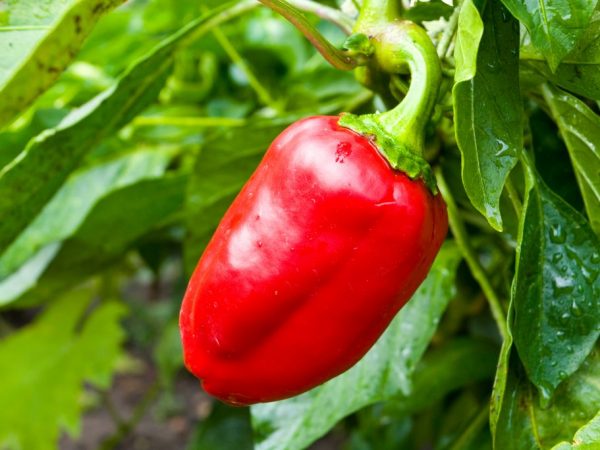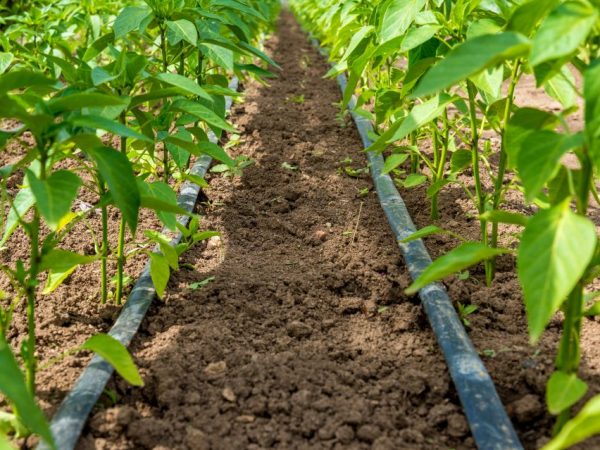Characteristics of the variety of peppers Zorka
The Zorka pepper variety is one of the most popular sweet varieties. Zorka pepper is appreciated for its excellent taste and high yield.

Characteristics of the Zorka pepper variety
Variety characteristic
Zorka is an early maturing and medium-sized variety. Already after 90-95 days, the bush gives its first fruits.
Advantages of the variety:
- unpretentiousness to growing conditions;
- ease of care;
- high level of disease resistance.
The fruits can be transported over long distances. They do not deteriorate during transportation.
Dawn can grow both in open ground and in greenhouses. Vegetable crops are grown both at home and on an industrial scale.
The only drawback of culture is that it is afraid of severe frosts. If the temperature drops below -20 ° C in winter, the plant is grown only in greenhouses.
Description of the bush
The bush is slightly leafy, that is, there are a small number of leaves on it, it is semi-sprawling. Reaches 45-55 cm in height.
Leaf Description:
- medium size;
- rich dark green color;
- slightly wrinkled.
One plant can have 8-9 fruits at a time. That is, from 1 sq. about 40 vegetables are harvested.
Description of the fetus
The fruits of the Dawn variety are drooping, have a prismatic shape, and are smooth.
Other characteristics of the fruit:
- large (weight - up to 130 g);
- fleshy;
- juicy;
- delicious.
The color changes as it matures. At first, the peppercorns can be light yellow, closer to the period of technical maturation - bright red.
The fruits are often eaten fresh, but are also used to make vegetable stews, lecho or pies. Stuffed peppers can be made from it. The fruits are great for preservation.
Planting pepper Dawn
Areas sheltered from the wind are suitable for planting. It is important that the plants are not in the shade.
Zorka peppers cannot be planted where tomatoes, eggplants and potatoes used to grow: they are affected by the same diseases, pests that can overwinter in the ground and infect new plantings.
Before planting, you do not need to fertilize the soil, especially nitrogen fertilizers and fresh manure: this can lead to the growth of the plant itself, which will negatively affect the yield of the bush.

Plants need sunlight
It is better to prepare in the fall:
- remove the remnants of previous crops;
- dig up a section of soil where Zorka is planned to land;
- apply fertilizers (superphosphate, wood ash, humus).
In the spring, before planting, the soil is only loosened. They are planted in open ground when frosts pass.
Before planting, holes are prepared, 2 liters of water are poured into each. Seedlings are taken out of the pots, buried in the holes a little deeper.
Vegetables are planted at a distance of 35-40 cm from each other. The optimal distance between the beds is 60-65 cm.
Care
Watering
Watering begins at the stage of planting in open ground. Seedlings are watered abundantly before removing from the pots.
The first time after planting is watered every 2 days.It is important not to damage young plants with a strong pressure of water; it is better to perform root watering by means of drip irrigation.
Watering is carried out in the early morning or evening so that the water is absorbed, and not instantly evaporated.
During the harvesting period, they are watered less often - once every 5 days. They are guided by soil moisture and air temperature.
Loosening and weeding
Loosening and weeding is carried out to remove weeds and enrich the soil with oxygen. An unsharpened hoe is often used.
Loosening is not carried out in the first 2 weeks after planting the pepper in the ground, since the thin roots can be severely damaged.
Then they are loosened one day after watering or depending on the overgrowth with weeds. During the fruiting period, you can huddle each pepper separately.
Top dressing
After planting, the Zorka pepper needs nutrients. He is fed 3 times. The first time - 10-12 days after planting in the ground. It is best to use a mixture of slurry (chicken droppings) and mineral fertilizers. Instead of manure (droppings), you can add ammonium nitrate.
Manure (litter) based solution recipe:
- in 10 liters of water, 1 liter of chicken manure (or 2 liters of manure), 50 g of superphosphate, 20 g of potassium chloride, 200 g of wood ash are diluted;
- let it brew for 1-2 hours;
- take 300 ml of solution for 1 bush.
Recipe with ammonium nitrate: 15 g of ammonium nitrate, 50 g of superphosphate and 20 g of potassium chloride are diluted in 10 liters of water. You do not need to insist, you must immediately apply at the root.
The second feeding is done when the ovary appears. Under each bush, 1 liter of manure diluted in water in a ratio of 1:10 is poured.
For the third time, the vegetable crop is fed when the fruits are ripe. The recipe is the same as for the first feeding.
Pests and diseases
Dawn is resistant to pests and diseases, but due to improper care, immunity deteriorates, and the plant becomes very vulnerable.
Too dense planting provokes the appearance of a black leg. The main symptom of the disease is darkening of the fruit. To save the plant, the amount of watering is reduced and the bush is treated with the Zaslon preparation.
Other diseases:
- late blight;
- brown spotting;
- mosaic.
To prevent their development, it is necessary to observe crop rotation and not overmoisten the soil. You should also make phosphorus and potassium fertilizers on time.
Conclusion
The Zorka variety stands out for its taste and technological qualities. Its high yield, early ripening of fruits and unpretentious care attract the attention of farmers.


